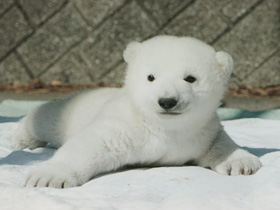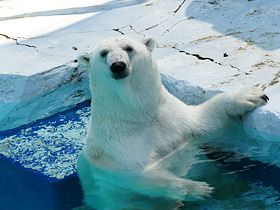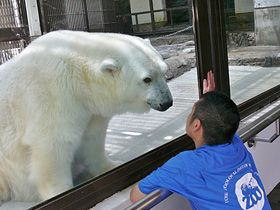Polar bear Peace
Polar bear Peace
Polar bear Peace
Hello! My name is Peace!
Peace-chan is a female polar bear that was born in the Tobe Zoo on December 2, 1999. Her small, white, stuffed-animal like looks were a hit with everyone. Her birthday party every year draws crowds who would flock in front of her room. She is the superstar of Tobe Zoo.
The Background Story to Peace-chan
Birth
The Start
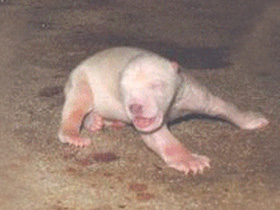 A polar bear cub was born at Tobe Zoo in December 2, 1999. There had been 122 polar bear cubs born in Japan up to that point, but the survival rate past 6 months was very low with only 16 cubs surviving, and there were no successful precedents of humans nursing a cub from a bottle.
A polar bear cub was born at Tobe Zoo in December 2, 1999. There had been 122 polar bear cubs born in Japan up to that point, but the survival rate past 6 months was very low with only 16 cubs surviving, and there were no successful precedents of humans nursing a cub from a bottle.
Of the two cubs born at Tobe Zoo, one had already been mauled by her mother when she was discovered. Attempts were made to resuscitate her, but she died two hours later. The other cub was switched to bottle nursing, and, one year later, she is developing well.
Notes on Rearing Peace-chan
Her parents are Pearl (male) and Ballyba (female). This was Ballyba's first birth.
4 Days After Birth
Milk Type and Concentration
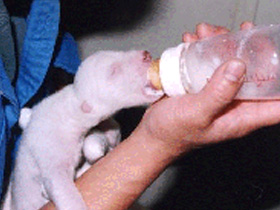
The first hurdle in starting bottle nursing was what type of milk to use and its concentration. Initially, she was given milk for sea carnivores; however, she experienced diarrhea and the milk was changed to dog milk which had a lower concentration. The concentration was gradually increased until she had settled on a milk to water concentration ratio of 1:4 or 5. Her nursing demeanor, abnormalities in weight, and degree of constipation were the three factors used to judge the suitability of the concentration. When she was observed to gain 150 to 300 grams in weight daily and she had almost no episodes of diarrhea, the right concentration had been reached.
Her daily milk consumption went from 200ml to 1800ml around the time her weaning began.
Hysteria
The next problem were bouts of hysteria. She would suddenly begin to wail, and this would last for hours. At first, the Zoo was at a loss of what the cause could be; however, after observing carefully, it was discovered that she was overheating and she was not passing all of her stool. When we removed those stressors, she got well.
Nursing Outside
Temperature Management
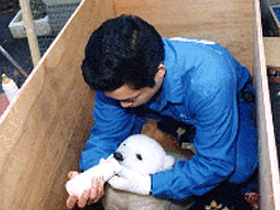
Temperatures for the cub were kept warm with a pet panel heater, similar to other carnivores, and her rearing pen was kept at 25℃. She started exhibiting signs of overheating around ten days after her birth, so the panel heater was removed on day 14, and her polystyrene rearing pen was kept at room temperature. However, when she was 30 days old she began to overheat again, so she was transferred to a wooden rearing pen. When her keepers thought they were in the clear, a mere 10 days later she began to overheat again. The heat was shut off in the keeper's room in which her rearing pen was located, and, ultimately, she began bottle nursing outside in temperatures below 10℃ since she required even lower temperatures as the days went by.
At nighttime and on holidays, her keeper would bring her back home and put her in the coldest place in the house with a window open.
Full-Time Keeper
In the wild, polar bears are born and raised in a snow cave in the arctic during winter, and they may spend as much as 6 months in there. During that time, a cub would only have contact with her mother and siblings, with very limited exposure to types of scents. Also, polar bear cubs are born with their eyes and ears closed, so it is thought that their olfactory sense is their only source of outside information. To prevent any stressors from information overload, she was reared by one full-time keeper only. She once had to be reared for three days after her full-time keeper had to go on a trip, and during that time she did not nurse well and dropped weight.
Vitamins and Iron
According to the literature from other countries, there have been cases of polar bear deaths due to a deficiency of vitamin B; therefore, general infant vitamin supplements were added to her milk beginning at the 20-day mark. She was also switched to pill-form vitamin supplements as she was weaned. Additionally, bottle fed cubs can develop an anemic iron deficiency, so she had intramuscular injections of an iron supplement once a month. We believe that these were the factors for her successful bottle nursing.
Moving to a Bear Hut
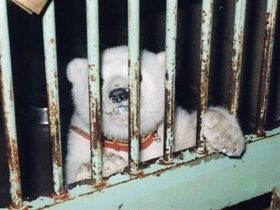
Up until she was 108 days old, her keeper would take her home at nighttime and during holidays; but, when her weight surpassed 15kg, it became difficult for her to be transported by car and rear at home, and on her 109th day, she was kept entirely in her bear hut, even at nighttime. At first, she could not accustom herself to that environment and would cry continually, sometimes crying herself hoarse. Even after she turned one year old, she would cry for several hours after her keeper went home for the day. This is likely a natural behavior for polar bear cubs that live with their mothers past the age of two years.
Weaning
At around 80 days old, she was prepared for weaning. This process began by having her lap up milk from a dish, but this did not go well since she would sometimes snort the milk up her nose or knock over the dish with her paws. 10 days after starting this regimen, she began to drink well, and she was moved to the next stage. She was then given solid food for the first time. She was provided with a prescription dog food (for kidney stone prevention) that was mashed into a paste in a mortar. She didn't even try to eat it at first, and began to eat it several days later. However, there was little protein content in this food, and was deemed to be inappropriate for a polar bear cub, which are prone to sudden growth. Next she was given minced chicken with bones as a calcium-packed feed. She palated this well, and ate with no reservations whatsoever. She subsequently accepted other food (dog food, apples, sausages etc.) with no trouble, and she had been completed weaning at the age of 156 days. She currently eats whole chickens, and is steadily putting on weight.
Swimming Practice
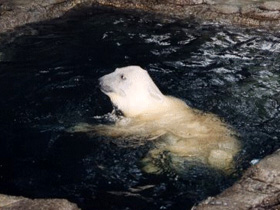
In order for polar bears to bear the hot summers of Japan, they must be able to enter water and swim. Peace's training for this began around the start of April with wetting her with water. At first, she was called to be placed in water inside a basin about 20cm deep, but she showed absolutely no interest at all. Next her keeper used a bottle of milk to tempt her to enter a pool in her paddock filled with water to a depth of 30cm. After several times of trying this, she would enter for a brief time only, and would not enter the pool of her own accord.
However, since she had learned how to swim, her keeper waited for her to become accustomed to water and enter a pool with a depth of 170cm. As a result of these efforts, on July 5, three months after her training started, she entered the pool for the first time herself and enjoyed her first swim. She spent two hours or more in the pool each day, and was thus able to bear the hot Japanese summers.
Various Problems
It has been one year since her birth, and reflecting back on the rearing process, there have been several problems, but none of which proved to be serious. I will outline each of these problems below.
Lead Poisoning
Several days after housing her in the bear hut, she exhibited light tremors. We suspected that she was suffering lead poisoning from absorbing the lead content of the rust paint used on the door to her pen, since she was observed to often lick it. She was given a sub-dermal injection of a chelating agent and her symptoms improved. An acrylic panel was placed over the door as a preventative measure against a recurrence.
Bloody Stool
When we provided her with a minced chicken with bones to wean her, she palated the food very well; however, blood was observed in her stool several days after this feeding regimen was started. When she was given boneless minced chicken there was no blood observed in her stool, so her minced feed was subsequently ground twice to make the bones more fine, leading to normal stool.
Fur Loss
At around five months of age, she exhibited patches of fur loss around the size of a 10 yen coin on her face and upper body. When her behavior was observed, she appeared to be rubbing herself against the wall to scratch an itch. I then carefully brushed her coat and removed large amounts of thermal-preserving birth down that cubs have during infancy, and this stopped all subsequent fur loss.
In Conclusion
The most important lesson learned in bottle nursing this polar bear cub is that one must not become bound by one's biases. Knowledge and experience are important; however, when one determines that everything must be 'this way', then one may lose sight of what it is the animal may be complaining about. I take this as a lesson for me to personally benefit from in the future.
Lastly, I would like to express my profound gratitude to the various people who gave me helpful advice at bottle nursing this cub.



 総合案内
総合案内 動物情報
動物情報 イベント/教育
イベント/教育 動物園サポーター
動物園サポーター お知らせ
お知らせ その他
その他